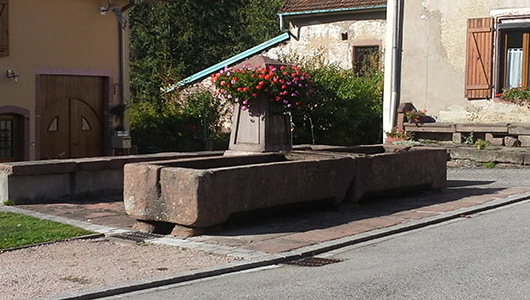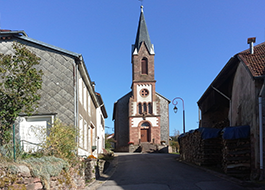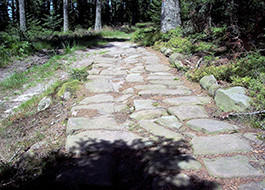Raon-lès-Leau
Durée visite : 75 minutes
Moyen : Pédestre
Le toponyme complet de la localité est récent, il n’apparaît qu’après la convention du 21 décembre 1751. Elle entérine le partage entre le duché de Lorraine, en pratique sous obédience française, et la principauté impériale autonome de Salm. La rive droite de la Plaine avec Raon-lès-l’Eau devient lorraine et française. L’autre partie de Raon, qui se nommera commune de Raon-sur-Plaine en rive gauche appartient à la principauté de Salm. La grande affaire de la commune est la restitution de ses espaces boisés. En effet, en 1871, lors de l’annexion de l’Alsace-Lorraine à l’Allemagne, les communes de Raon-lès-Leau et de Raon-sur-Plaine ont été amputées d’une partie de leurs forêts. En 1919, le découpage administratif est maintenu, au grand bénéfice de la commune alsacienne de Grandfontaine. De vives protestations raonnaises s’élèvent en vain. Les maires ont écrit aux préfets, aux présidents Mitterrand, Chirac et Sarkozy. Bien que leur demande soit tout à fait légitime, la réponse fut toujours la même. Il serait en effet trop complexe de modifier les frontières de trois départements. Mais dans les villages lorrains cette décision ne passe pas. Un avocat va donc attaquer, devant le tribunal administratif, l’Etat français. Les communes réclament la restitution des 2000 ha de terrains qu’on leur a confisqué, ou à défaut, une indemnité compensatoire.
The complete toponym of the locality is recent, it appears only after the convention of December 21, 1751. It confirms the division between the duchy of Lorraine, in practice under French obedience, and the imperial autonomous principality of Salm. The right bank of the Plain with Raon-lès-l’Eau becomes Lorraine and French. The other part of Raon, which will be named commune of Raon-on-Plaine on the left bank belongs to the principality of Salm. The big business of the town is the restitution of its wooded areas. In 1871, during the annexation of Alsace-Lorraine to Germany, the communes of Raon-lès-Leau and Raon-sur-Plaine were cut off from part of their forests. In 1919, the administrative division is maintained, to the great benefit of the Alsatian town of Grandfontaine. Violent protests in the Rhône arose in vain. The mayors wrote to the prefects, to presidents Mitterrand, Chirac and Sarkozy. Although their request is perfectly legitimate, the answer was always the same. It would be too complex to change the boundaries of three departments. But in the Lorraine villages this decision does not pass. A lawyer will therefore attack, in the administrative court, the French State. The municipalities claim the restitution of the 2000 ha of land that has been confiscated, or failing that, compensation..
Die vollständige Ortsbezeichnung ist neu, erscheint erst nach der Konvention vom 21. Dezember 1751. Sie bestätigt die Trennung zwischen dem Herzogtum Lothringen, das unter französischem Gehorsam praktiziert wird, und dem kaiserlichen autonomen Fürstentum Salm. Das rechte Ufer der Tiefebene mit Raon-lès-l’Eau wird zu Lothringen und Französisch. Der andere Teil von Raon, der am linken Ufer der Gemeinde Raon-on-Plaine genannt wird, gehört dem Fürstentum Salm. Das große Geschäft der Stadt ist die Restitution der Waldgebiete. Im Jahr 1871 wurden die Gemeinden Raon-lès-Leau und Raon-sur-Plaine während der Annexion von Elsass-Lothringen an Deutschland von einem Teil ihrer Wälder abgeschnitten. Im Jahr 1919 wird die administrative Aufteilung zum Vorteil der elsässischen Stadt Grandfontaine beibehalten. Gewaltsame Proteste in der Rhône waren vergeblich. Die Bürgermeister schrieben den Präfekten, den Präsidenten Mitterrand, Chirac und Sarkozy. Obwohl ihre Anfrage absolut legitim ist, war die Antwort immer die gleiche. Es wäre zu komplex, die Grenzen von drei Abteilungen zu ändern. In den lothringischen Dörfern fällt diese Entscheidung jedoch nicht. Ein Rechtsanwalt greift daher vor dem Verwaltungsgericht den französischen Staat an. Die Kommunen fordern die Rückerstattung von 2000 Hektar konfisziertem Land oder, wenn dies nicht gelingt, eine Entschädigung.

De gueules à une cotice d’or et une traverse ondée d’argent passées en sautoir, accompagnées en chef et en pointe d’un besant d’argent, et accostées de deux saumons du même, une crosse abbatiale d’azur brochant sur le tout.
La traverse ondée symbolise la Plaine et la cotice le gué. La cotice est d’or pour indiquer qu’il fallait payer pour traverser la rivière. Les deux saumons rappellent que Raon faisait partie du comté de Salm. Un besant représente le fromage et l’autre la meule de moulin, spécialités du pays. L’abbaye de Saint Sauveur a possédé Raon, ce qui explique la présence de la crosse.
The wavy crossing symbolizes the Plain and the cotice the ford. The cotice is gold to indicate that you had to pay to cross the river. The two salmon are a reminder that Raon was part of Salm County. One besant represents the cheese and the other the millstone, specialties of the country. The abbey of Saint Sauveur possessed Raon, which explains the presence of the butt.
Die gewellte Kreuzung symbolisiert die Ebene und die Cotice die Furt. Das Cotice ist Gold, um anzuzeigen, dass Sie zahlen mussten, um den Fluss zu überqueren. Die beiden Lachse erinnern daran, dass Raon Teil von Salm County war. Ein Besant repräsentiert den Käse und der andere den Mühlstein, die Spezialitäten des Landes. Die Abtei von Saint Sauveur besaß Raon, was die Anwesenheit des Hinterns erklärt.
Les points de visites
.
La population de la commune croît au XIXe siècle. On passe de 188 habitants en 1793 à 295 en 1876. Elle ne cessera de diminuer ensuite pour atteindre 16 personnes en 1982. Dans ces conditions les commerces sont amenés à disparaître. C’est le cas de ce café. Et ce n’est pas une exception. Il existait 600 000 bistrots en France en 1960, il en reste 34 000 en 2016. Au café, on parle de tout et de rien. Pendant longtemps, et jusque vers 1970, le café est le lieu où circule l’information et les rumeurs. On ne parle pas encore de fake news et de réseaux sociaux. C’était un autre temps. Observez la taille monumentale de la banquette.
The population of the town grew in the nineteenth century. It goes from 188 inhabitants in 1793 to 295 in 1876. It will continue to decrease then to reach 16 people in 1982. In these conditions the businesses are brought to disappear. This is the case of this coffee. And this is not an exception. There were 600,000 bistros in France in 1960, there are 34,000 left in 2016.In the café, we talk about everything and nothing. For a long time, until about 1970, coffee is the place where information and rumors circulate. We are not yet talking about fake news and social networks. It was another time. Observe the monumental size of the bench.
Die Bevölkerung der Stadt wuchs im 19. Jahrhundert. Sie geht von 188 Einwohnern im Jahr 1793 auf 295 im Jahr 1876. Sie wird weiter sinken, um 1982 16 Personen zu erreichen. Unter diesen Bedingungen werden die Unternehmen zum Verschwinden gebracht. Dies ist der Fall dieses Kaffees. Und das ist keine Ausnahme. 1960 gab es in Frankreich 600.000 Bistros, 2016 waren noch 34.000 übrig. Im Café reden wir über alles und nichts. Lange Zeit, bis etwa 1970, ist Kaffee der Ort, an dem Informationen und Gerüchte kursieren. Wir reden noch nicht über falsche Nachrichten und soziale Netzwerke. Es war ein anderes Mal. Beachten Sie die monumentale Größe der Bank.
.
.
L’église de la Nativité de la Vierge date du XIXe siècle. Le 3 décembre 1871, la paroisse de la commune, considérée par l’épiscopat français comme martyre, est consacrée au Sacré-Coeur de Jésus. Le 13 décembre 1906, avec la retraite du curé, il n’y a plus aucun desservant ni service pastoral ou dominical à Raon-lès-Leau. La paroisse est alors rattachée à celle de Raon-sur-Plaine. Les évangélistes ne nous disent pas où est née Marie. On sait seulement qu’elle était parente d’Elisabeth qui habitait en Judée. Il n’est donc pas impossible qu’elle soit elle-même originaire de Jérusalem. Une antique tradition, dont on trouve trace dans l’évangile apocryphe de Jacques, nous parle des parents de la Vierge, Joachim et Anne. Il existait également et très anciennement, à Jérusalem, une maison appelée la Maison d’Anne. Près de cette maison fut érigée une église dont la dédicace eut lieu un 8 septembre. L’anniversaire de cette dédicace fut commémoré chaque année. La fête s’étendit à Constantinople au 5ème siècle puis en Occident. Plus tard, on lui adjoignit la fête de sa conception, neuf mois auparavant d’où le 8 décembre. La Nativité de Marie est une des grandes fêtes de l’année liturgique. Elle inaugure l’économie du salut et l’inscription du Verbe de Dieu dans l’histoire des hommes.
The Church of the Nativity of the Virgin dates from the nineteenth century. On December 3, 1871, the parish of the commune, considered by the French episcopate as martyrdom, is dedicated to the Sacred Heart of Jesus. On December 13, 1906, with the priest’s retirement, there is no longer any serving or pastoral or Sunday service in Raon-lès-Leau. The parish is then attached to that of Raon-sur-Plaine. The evangelists do not tell us where Mary was born. We only know that she was a relative of Elizabeth who lived in Judea. It is not impossible that she herself comes from Jerusalem. An ancient tradition, found in the apocryphal gospel of James, tells us of the parents of the Virgin, Joachim and Anne. There was also, and very early in Jerusalem, a house called Anne’s House. Near this house was erected a church whose dedication took place on September 8th. The anniversary of this dedication was commemorated each year. The feast spread to Constantinople in the 5th century and then in the West. Later, he was joined the feast of his conception, nine months before from December 8. The Nativity of Mary is one of the great festivals of the liturgical year. It inaugurates the economy of salvation and the inscription of the Word of God in the history of men.
Die Kirche der Geburt der Jungfrau Maria stammt aus dem 19. Jahrhundert. Am 3. Dezember 1871 wird die Pfarrgemeinde der Kommune, die vom französischen Episkopat als Martyrium betrachtet wird, dem Heiligen Herzen Jesu gewidmet. Am 13. Dezember 1906, mit dem Ruhestand des Priesters, gibt es in Raon-lès-Leau keine Gottesdienste, Hirten- oder Sonntagsdienste mehr. Die Gemeinde ist dann an die von Raon-sur-Plaine angeschlossen. Die Evangelisten sagen uns nicht, wo Maria geboren wurde. Wir wissen nur, dass sie eine Verwandte von Elizabeth war, die in Judäa lebte. Es ist nicht unmöglich, dass sie selbst aus Jerusalem kommt. Eine alte Tradition, die im apokryphen Evangelium von Jakobus gefunden wurde, erzählt uns von den Eltern der Jungfrau Joachim und Anne. Es gab auch und sehr früh in Jerusalem ein Haus, das Anne’s House genannt wurde. In der Nähe dieses Hauses wurde eine Kirche errichtet, deren Einweihung am 8. September stattfand. Der Jahrestag dieses Engagements wurde jedes Jahr gefeiert. Das Fest breitete sich im 5. Jahrhundert nach Konstantinopel und dann im Westen aus. Später war er neun Monate zuvor, am 8. Dezember, am Fest seiner Vorstellung beteiligt. Die Geburt Christi ist eines der großen Feste des liturgischen Jahres. Es leitet die Erlösungsökonomie und die Inschrift des Wortes Gottes in die Geschichte der Menschen ein.
.
Sur les hauteurs du petit village de Raon-les-Leau, on peut faire une balade en prenant une belle voie romaine. Elle serpente à travers la forêt de Roule-Bacon, appartenant au Massif du Donon. Construite voilà près de 2 000 ans, cette voie permettait de relier les grandes villes gallo-romaines de Langres à Strasbourg, en passant par Tarquimpol. Elle est identifiée comme le Chemin d’Allemagne qui reliait jadis la Lorraine à l’Alsace. La voie permettait la circulation des individus et des marchandises. Ainsi, les légions romaines pouvaient ainsi rallier, au plus vite, les lieux où elles étaient appelées. Les échanges commerciaux intenses, avec notamment le commerce du sel en provenance du Saulnois, passaient inévitablement par l’utilisation de cette chaussée. Ainsi, sur plus d’un kilomètre, la voie, constituée de dalles de grès vosgien, est bien visible. Le début de la chaussée antique, après le refuge de Roule-Bacon, est presque intégralement conservée, sur environ 200 mètres. Elle devient ensuite de plus en plus dégradée, laissant place à la végétation. On peut notamment remarquer les restes d’ornières usées par le trafic des chars et autres chariots.
On the heights of the small village of Raon-les-Leau, you can take a walk along a beautiful Roman road. It winds through the forest of Roule-Bacon, belonging to the Massif du Donon. Built nearly 2,000 years ago, this route made it possible to connect the major Gallo-Roman cities from Langres to Strasbourg, via Tarquimpol. It is identified as the Way of Germany that once linked Lorraine to Alsace. The way allowed the circulation of individuals and goods. Thus, the Roman legions could thus rally, as soon as possible, the places where they were called. The intense trade, especially with the salt trade from the Saulnois, inevitably went through the use of this road. Thus, for more than one kilometer, the road, consisting of slabs of Vosges sandstone, is clearly visible. The beginning of the ancient causeway, after the refuge of Roule-Bacon, is almost entirely preserved, about 200 meters. It then becomes more and more degraded, giving way to vegetation. One can notably note the remains of ruts worn by the traffic of the tanks and other trolleys.
Auf den Höhen des kleinen Dorfes Raon-les-Leau können Sie einen Spaziergang entlang einer schönen Römerstraße machen. Es windet sich durch den Wald von Roule-Bacon, der zum Massif du Donon gehört. Diese vor fast 2.000 Jahren erbaute Route verband die großen galloromanischen Städte Langres über Tarquimpol mit Straßburg. Es wird als der deutsche Weg bezeichnet, der einst Lothringen mit dem Elsass verband. Die Strecke ermöglichte den Transport von Personen und Gütern. So konnten die römischen Legionen so schnell wie möglich die Orte sammeln, zu denen sie berufen wurden. Der intensive Handel, insbesondere der Salzhandel von Saulnois, beinhaltete unweigerlich die Nutzung dieses Dammes. So ist über mehr als einen Kilometer die aus Vogesen-Sandsteinplatten bestehende Strecke deutlich sichtbar. Der Beginn der alten Straße nach der Roule-Bacon-Zuflucht ist über 200 Meter fast vollständig erhalten. Es wird dann immer mehr abgebaut und weicht der Vegetation. Man kann besonders die Überreste von Spurrillen bemerken, die vom Verkehr mit Panzern und anderen Wagen getragen werden.








